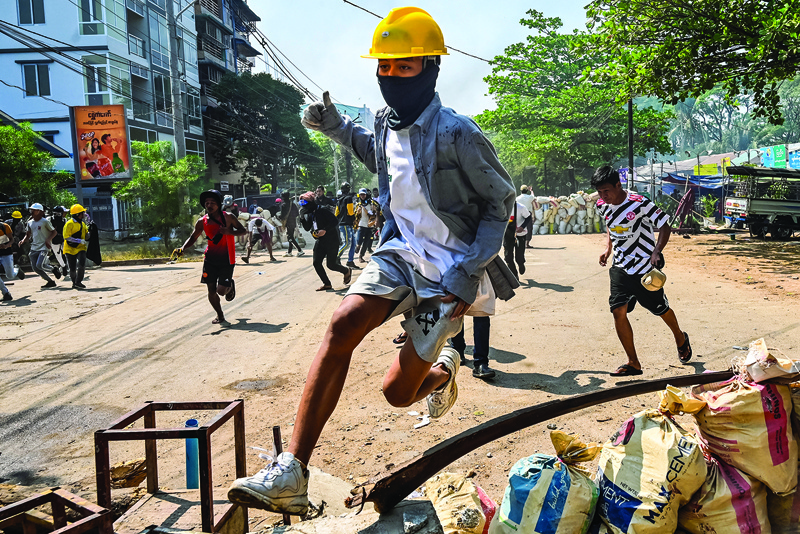 YANGON: A protester jumps over a makeshift barricade during a crackdown by security forces on a demonstration against the military coup in Yangon's Thaketa township yesterday.—AFP
YANGON: A protester jumps over a makeshift barricade during a crackdown by security forces on a demonstration against the military coup in Yangon's Thaketa township yesterday.—AFPYANGON: Protesters took to the streets across Myanmar again yesterday, defying the junta which has increasingly sought to crush the uprising with a campaign of violence and fear. The country has been in turmoil since the military ousted civilian leader Aung San Suu Kyi from power in a February 1 coup, triggering a nationwide uprising as protesters call for a return to democracy.
So far, more than 230 people have been killed in anti-coup unrest, according to a local monitoring group, as security forces have deployed tear gas, rubber bullets and live rounds against anti-coup protesters. But the movement has pushed ahead-albeit in smaller numbers.
Local media showed protesters in gas masks gathering in northern Shan state, while in the southern coastal city of Dawei, motorists hoisted posters of Suu Kyi and signs that said "end the dictatorship". The protesters in Shan state hoisted home-made shields that said "protect unarmed civilians".
Outside of protests, crackdowns by security forces continue on the streets and residential areas across Myanmar, said the Assistance Association for Political Prisoners monitoring group. "Casualties and unprovoked shootings are increasing day by day," it said. In the central ruby-producing city of Mogok, local media Myanmar Now reported that a small quarter's night guards were shot overnight.
"One died on the spot last night while two others are in critical condition in the hospital," a rescue team member confirmed to AFP, declining to give more details. Commercial hub Yangon has emerged as a hotspot for unrest, as security forces armed with guns continue to root out protesters wielding homemade protection gear.
But the resistance movement remains defiant. "Who says we have to give up because of unequal weapons? We are born for victory," tweeted prominent activist Ei Thinzar Maung, with the hashtag #SpringRevolution. Tom Andrews, UN special rapporteur on the human rights situation in Myanmar, said the junta could not defeat a population "united in peaceful opposition" against its rule.
"Desperate, it launches ruthless attacks to provoke a violent response to try and justify even more violence," he tweeted yesterday. "It's not working. The world must respond by cutting their access to money & weapons. Now." Makeshift barricades of bamboo, brick and burning rubber tyres have lent the streets of Myanmar's largest city the look of an urban warzone, and now the military are forcing civilians to dismantle them, piece by piece... at gunpoint.
Constructed using any material to hand, the barriers that have sprung up across Yangon offer scant protection against the live rounds the security forces have resorted to with increasing frequency and lethal effect to crush mass opposition to the February 1 coup that ousted elected civilian leader Aung San Suu Kyi.
The protesters have the numbers, but no real means of fighting the tear gas, rubber bullets and rifle fire of the army and police. The Assistance Association for Political Prisoners monitoring group suggests around 230 people have been killed in the unrest, and the actual toll across the country is believed to be far higher.
The barricades have become something of a protester trademark, blocking main roads and employing everything from sand-filled cement bags and bamboo screens to large, wheely garbage bins and housing bricks. They have been partially successful in slowing down the movement of the security forces, who are now intent on forcing local residents-including those not involved in the protests-to dismantle and remove them. Tun Hla, 60, was at home when armed personnel banged on his door and demanded he work on clearing a barrier erected in his neighborhood. "I have experienced this kind of situation before and it shouldn't happen again," Tun Hla, not his real name, told AFP.
The February coup brought an abrupt end to a 10-year experiment with democracy in Myanmar, which had previously been under strict military rule for five decades. During that period under the junta, it was typical for military personnel across the country to order families to provide one able-bodied person to perform backbreaking work. "This use of forced labor is nothing new in Myanmar," said John Quinley of Fortify Rights, adding that it was a "brutal tactic used to create an environment of fear and intimidation".
Despite being afflicted with chronic back pain, Tun Hla had no option but to follow the orders of the armed guards and-hiding his children at home-joined his neighbors in removing the sandbags and bamboo poles piled up in the street. "I was worried for my children since... there are young people dying," he said. - AFP










